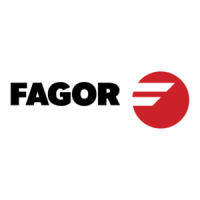Installation manual
CNC 8035
LOGIC CNC INPUTS AND OUTPUTS
Axis logic inputs.
10.
(SOFT M: V15.3X)
(S
OFT T: V16.3X)
·341·
AXIS+1 (M5108) | AXIS-1 (M5109)
AXIS+2 (M5158) | AXIS-2 (M5159)
AXIS+3 (M5208) | AXIS-3 (M5209)
The CNC uses these signals when working in the manual (JOG) operating mode.
If the PLC sets one of these signals high, the CNC will move the corresponding axis in the direction
indicated, positive (+) or negative (-). This movement will be performed at the feedrate override %
currently selected.
The treatment which these signals receive is similar to that given to the JOG keys of the operator
panel.
SPENA1 (M5110) | DRENA1 (M5111)
SPENA2 (M5160) | DRENA2 (M5161)
SPENA3 (M5210) | DRENA3 (M5211)
The CNC uses these signals when communicating with the drive via CAN. Every time the PLC sets
one of these signals high, the CNC lets the corresponding drive know about it.
These signals correspond to the "speed enable" and "drive enable" signals of the drive. The drive
manual describes how the two signals work, however, remember the following:
• Both signals must be initialized low when powering up the PLC.
• For normal drive operation, both signals must be set high.
• A down flank (trailing edge) of the DRENA signal (drive enable) turns off the power circuit of the
drive and the motor loses its torque. In this situation, the motor is no longer governed and it will
stop when its kinetic energy runs out. (Stop by friction).
• A trailing edge of the SPENA signal (speed enable) switches the "internal velocity reference"
to "0" rpm and brakes the motor while maintaining its torque. Once the motor has stopped, the
drive's power circuit is turned off and the motor has no torque.
ELIMINA1 (M5113) ELIMINA2 (M5163) ELIMINA3 (M5213)
If the PLC sets one these signals high, the CNC does not display the corresponding axis but keeps
controlling it. Same as when setting a.m.p. DFORMAT (P1) =3.
The ELIMINA mark can be activated and deactivated at any time and it also cancels the feedback
alarms which the machine parameter does not do.
SMOTOF1 (M5114) SMOTOF2 (M5154) SMOTOF3 (M5214)
The SMOTIME (P58) filter set for each axis with parameter P58 can be canceled from the PLC.
This SMOTIME filter will be activated or deactivated at the beginning of the block. If one of these
logic inputs is activated or deactivated while the CNC is overlapping blocks being executed in round
corner, it will be ignored until that operation is finished.
LIM1OFF (M5115) LIM2OFF (M5165) LIM3OFF (M5215)
The PLC sets one of these signals high so that the CNC ignores the software limits of the
corresponding axis.
MANINT1 (M5116) MANINT2 (M5166) MANINT3 (M5216)
The PLC sets one of these signals high to activate the additive handwheel on each axis. Only one
additive handwheel may be enabled at a time. If there are more than one mark active, only the first
one will be attended to.
When a program is in execution and the mark associated with an axis is activated, it calculates the
movement to be applied to that axis according to the resolution of the handwheel.

